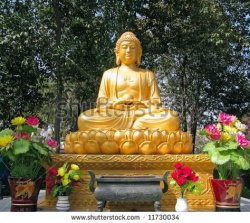Samyutta Nikāya
The Samyutta Nikaya, the third division of the Sutta Pitaka, contains 2,889 suttas grouped into five sections (vaggas). Each vagga is further divided into samyuttas, each of which in turn contains a group of suttas on related topics. The samyuttas are named according to the topics of the suttas they contain. For example, the Kosala Samyutta (in the Sagatha Vagga) contains suttas concerning King Pasenadi of Kosala; the Vedana Samyutta (in the Salayatana Vagga) contains suttas concerning feeling (vedana); and so on.
An excellent modern print translation of the complete Samyutta Nikaya is Bhikkhu Bodhi's The Connected Discourses of the Buddha: A New Translation of the Samyutta Nikaya (Boston: Wisdom Publications, 2000; originally published in two volumes, but now available in a single volume). A fine anthology of selected suttas is Handful of Leaves (Vol. 2), by Thanissaro Bhikkhu (distributed by the Sati Center for Buddhist Studies).
The suttas are numbered here by samyutta (chapter) and sutta, with the suttas numbered sequentially from the start of each samyutta, using as a guide the Rhys Davis & Woodward PTS English translations of the Samyutta Nikaya (The Book of the Kindred Sayings). The braces {} that follow each sutta and samyutta title contain the corresponding volume and starting page number, first in the PTS romanized Pali edition of the Samyutta Nikaya, then in Bhikkhu Bodhi's Connected Discourses of the Buddha ("CDB"). The translator appears in the .
One of the five divisions of the Sutta Pitaka.
It consists of 7,762 suttas, (DA.i.17; Gv. 56) and, at the First Council, was given in charge of Mahā Kassapa and his pupillary succession (nissitaka). (DA.i.15).
The Nikāya is divided into five main Vaggas and fifty six sections, called Samyuttas, each Samyutta being again subdivided into minor Vaggas or chapters.
Buddhaghosa, wrote a Commentary on the Samyutta, called Sāratthappakāsinī.
The Samyutta Nikāya is quoted in the Milinda-Pañha. E.g., pp. 137, 242, 377, 379; see also Vin.ii.306, where Uposatha Samyutta is mentioned, but what is evidently meant is the Uposatha Khandhaka.
Kittisirirājasīha, king of Ceylon, had the Samyutta Nikāya copied by scribes (Cv.xcix.33). One of the Samyuttas, the Anamatagga, was preached by Rakkhita in Vanavāsa (Mhv.xii.32) and by Mahinda in Ceylon (Mhv.xv.186), soon after their respective arrivals in these countries, at the conclusion of the Third Council. The Nikāya has been translated into Burmese. Bode, op. cit., 92.
Contents
Preface
Part One: The Section with Verses (Sagaathaka Vagga)
Devataa Sa.myutta ('[The Group on] Devas')
Doomed (1. 1. 3.)
Vain Conceits (1. 1. 9)
Difficult (or The Tortoise) (1. 2. 7.)
Samiddhi (1. 2. 10.)
The Arahant (1. 3. 5.)
Devaputta Sa.myutta ('Sons of the Devas')
Taayana (2.1.8.)
Jantu (2.3.5.)
Kosala Sa.myutta ('At Kosala')
Mallikaa (3.1.8)
A Heavy Meal (3.2.3.)
Braahma.na Sa.myutta ('Brahmans')
Dhanañjaani (7.1.1.)
Abuse (7.1.2.)
Sangaarava (7.2.11)
Part Two: The Section on Causation (Nidaana-Vagga)
Nidaana Sa.myutta ('Causation')
Gotama, the Great Sage of the Sakyas (SN 12.10)
Kaccaayana (SN 12.15)
The Teacher of Dhamma (SN 12.16)
Naked Kassapa (part) (SN 12.17)
From the 'Ten Powers' Sutta (SN 12.22)
From the Upanisaa Sutta (SN 12.23)
Volition (SN 12.38)
Aananda's Mistake (SN 12.60)
Kassapa Sa.myutta ('About Kassapa')
Contentment (SN 16.1)
Carelessness (SN 16.2)
False Dhamma (SN 16.13)
Labhasakkara Sa.myutta ('Gains and Favors')
The Dung-Beetle (SN 17.5)
Bhikkhu Sa.myutta ('About Monks')
Nanda (SN 21.8)
Part Three: The Section on the Aggregates (Khandha-Vagga)
Khandha Sa.myutta ('The Aggregates')
Grasping and Worry (SN 22.7)
The Burden (SN 22.22)
An Island to Oneself (SN 22.43)
Ways of Regarding (SN 22.47)
So.na (or Conceit) (SN 22.49)
Clinging (SN 22.63)
Going Begging (part): A Stern Admonition (SN 22.80)
Tissa the Waverer (part) (SN 22.84)
Anuraadha is Caught Out (SN 22.86)
Vakkali (part): Seeing the Dhamma (SN 22.87)
Khemaka (part) (SN 22.89)
The Sotaapanna ('Stream-Winner') (SN 22.109)
The Arahant (SN 22.110)
Part Four: The Section on the Sixfold Sense-Base (Salaayatana Vagga)
Salaayatana Sa.myutta ('The Sixfold Sense-Base')
Migajaala (or Dwelling Alone) (SN 35.63)
Maalu"nkyaputta (SN 35.95)
Saariputta (SN 35.120)
Bhaaradvaaja Instructs a King (SN 35.127)
Lohicca (SN 35.132)
Verahaccaani (or How to Listen to Dhamma) (SN 35.133)
Kamma (SN 35.145)
Is There a Criterion (SN 35.152)
The Ocean (SN 35.187)
Ko.t.thika (SN 35.191)
Things Productive of Suffering (extracts) (SN 35.203)
The 'What's It' Tree (Ki.msuka) (SN 35.204)
The Ox (from section entitled 'The Lute') (SN 35.205)
The Six Animals (part) (SN 35.206)
Moggallaana Sa.myutta ('About Moggallaana')
The Signless (SN 40.9)
Citta Sa.myutta ('About the Householder Citta')
Seeing the Sick (Citta) (SN 41.10)
Gaamani Sa.myutta ('About Village Headmen')
Teaching (SN 42.7)
Part Five: The Great Section (Mahaa-Vagga)
Magga Sa.myutta ('About the Path')
For All Comers (SN 45.159)
Suffering (SN 45.165)
Bojjhanga Sa.myutta ('About the Factors of Enlightenment')
Fire (or Right and Wrong Times) (SN 46.53)
The Brahma-Vihaaras (SN 46.54)
Sangaarava (or The Hindrances) (SN 46.55)
Satipa.t.thaana Sa.myutta ('About Mindfulness')
Mindfulness (from The Nuns' Lodging) (SN 47.10)
Obligation (Paa.timokkha) (SN 47.46)
Indriya Sa.myutta ('About the Faculties')
The Brahman U.n.naabha (SN 48.42)
In the Foot (SN 48.54)
Sotapatti Sa.myutta ('About Stream-Winners')
Sarakaani (Who Took to Drink) (SN 55.24)
Sacca Sa.myutta ('About the (Four Noble) Truths')
Wordy Warfare (SN 56.9)
Knowledge (SN 56.22)
The Si.msapaa Leaves (SN 56.31)
Abbreviations
Notes
Preface
Unlike the anthology of the A.nguttara Nikaaya in this series by the Ven. Nyaanaponika, this selection from the Sa.myutta is by three different hands: Part I (WH 107-109) by John D. Ireland, Part II (WH 183-185) by the Ven. Ñaa.nananda, and Part III by the undersigned. Since the choice of each translator ranged over the entire Nikaaya, the three parts do not present the whole material in canonical order. Accordingly an index has been provided showing all extracts in that order. A certain lack of terminological consistency was another unavoidable disadvantage, though this is in practice probably not very serious. It should further be noted that the Anthology does not include three important items — the Buddha's first three sermons — since these have already appeared in No. 17 of the Wheel series. With one small exception, too, the important Vedana Sa.myutta (SN 36) is not represented, because a separate translation of it has meanwhile been published (WH 303-304).
The full translation of the Sa.myutta Nikaaya published by the Pali Text Society runs to five volumes, the first two by Mrs C.A.F Rhys Davids (who edited the whole), and the last three by F.L. Woodward. In the preface to Vol. I Mrs Rhys Davids wrote: "It has been more than once suggested that a volume of selections would be of more instant service than would be afforded by the long drawn out appearance of the whole work in its original order... it will be for a later generation to exercise private judgment in compiling eclectic extracts." And indeed anyone familiar with that translation, or with the original will, be likely to agree that a version drastically pruned of much repetitive material is desirable. This selection may be regarded as a contribution towards such a version, which is to be wished for not only in the interests of concision, but because, despite the eminence and the devotion of the original translators, their version has many shortcomings. A certain number of actual mistakes have here been corrected by all three translators, but also many stylistic changes have been deemed necessary. The prose (and the verse!) of the earlier version is often intolerably stilted, sometimes to a point where it is almost unreadable, indeed, scarcely perhaps intelligible, to some present-day readers. Another difference is that whereas the PTS version was intended for a limited, fairly scholarly and largely non-Buddhist public, the present rendering will doubtless be used mainly by practicing Buddhists all over the world, to many of whom English is not their mother tongue but the language of international discourse.
It may safely be claimed that, by presenting their version in good modern English, free from archaic frills, the translators will have succeeded in bringing the message of the Buddha, as found in this Sa.myutta, closer to the reader. It is also safe to say that many will be surprised and delighted at the wealth that it contains, by its vivid similes and occasional humor. Thus in the present volume the reader will find the delightful story of the female deva who tried to tempt a young and handsome bhikkhu, and of how the Buddha dealt with the situation; of how the Buddha persuaded King Pasenadi not to over-eat; we hear how Nanda, the Buddha's cousin, paraded before the Teacher with well-pressed robes and painted eyes; of how the Buddha coped with angry Brahmans and how the Ven. Udaayii taught a Brahman lady to show proper respect for the Sangha; from the Ven. Khemaka we even learn something of what it feels like to be an anaagaamin. There is comfort and hope, too, for those who may feel their human weaknesses debar them from progress, and besides mindfulness we are reminded of the value of faith (not of course blind faith, but a reasoned confidence in the Teacher).
The Sa.myutta Nikaaya deserves to be better known among Western Buddhists than it appears to be, and it is to be hoped that this anthology will help to bring its many treasures to a wider readership.
M.O'C. Walshe
St. Albans, November 1981





